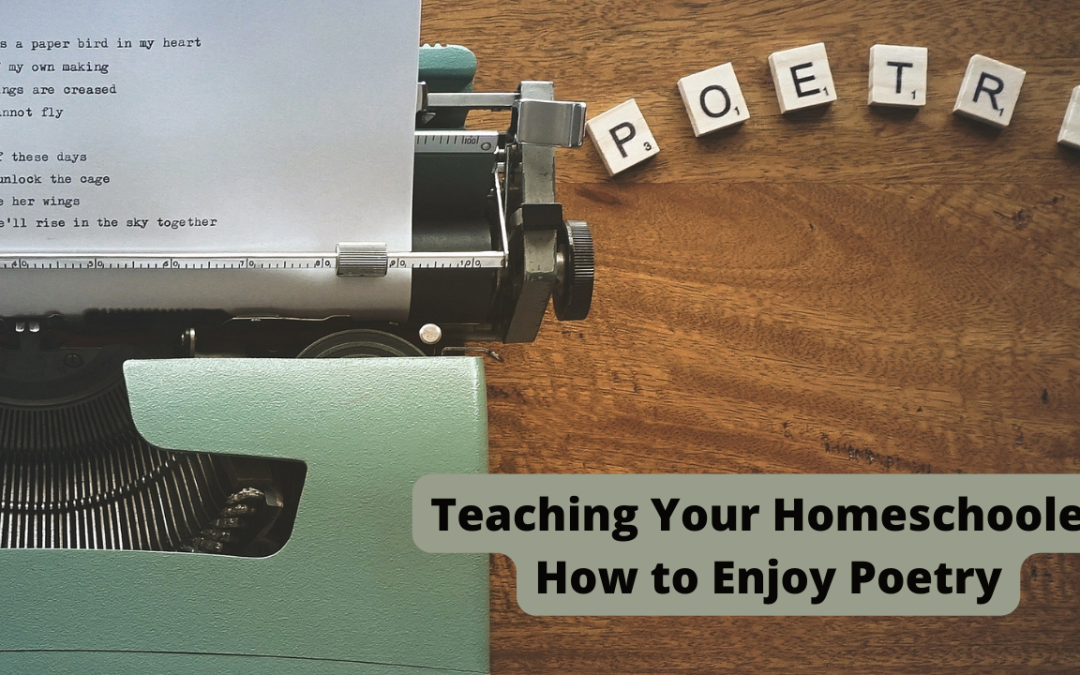Most of us have some memory of learning to recite a well-known poem. “Trees” by Joyce Kilmer. “Stopping By Woods on a Snowy Evening” by Robert Frost. A friend of mine, 40 years later, could still recite all the words of “The Charge of the Light Brigade” by Alfred Lord Tennyson. Reading poetry out loud with your student and encouraging them to read poetry out loud and memorizing shorter poems and passages can give both of you the excellent experience of listening to the beauty of words. If you’re working to teach your child how to enjoy poetry and write poetry, the goal should not be to analyze the meaning of poems, but to encourage your student to think “I can do that! I can write a poem!”
It’s important to remember that even kids who say they aren’t interested in poetry often use a form of poetry when they’re trying to memorize facts. When I was a kid, mnemonic verse helped me to memorize the order of the planets in the solar system: “Many Very Eminent Men Are Justly Satisfied Using Novelty Paperclips.” Or: Mercury, Venus, Earth, Mars, Asteroids, Saturn, Uranus, Neptune, and Pluto. Of course, in 2006, Pluto was eliminated as a true planet, but I still remember the mnemonic verse.
Kids will often tell you that poetry is a dead art and is too hard to understand. But poetry can also be about kids and written by kids.
HOW CAN POETRY HELP MY HOMESCHOOL STUDENT?
The word poetry originates in the earliest forms of the Greek language. “Poetry” translates literally to “I Create.” This “I create idea” can be used to generate excitement if you work at it. “Want to create something today? All we need for building supplies are WORDS!”
Learning to read and write poetry can contribute to your child’s intellectual development in many positive ways.
- Experiencing poetry assists in the development of your child’s reflective senses including – the inner ear, the imagination and learning how to respond in a more subtle way to suggestions and words from others.
- Learning to appreciate and write poetry gives your child a sense of the magnificent and beautiful images that can be created using only words as building blocks.
- By introducing a variety of poets to your student, he or she will be able to experience how individuality can be expressed through words.
- Being guided through poetry writing exercises will give your child the opportunity to express themselves in both subtle and precise ways.
HOW TO INTRODUCE POETRY TO YOUR HOMESCHOOLER
When I was teaching creative writing to kids, I found they were most interested in hearing poems actually written about children. In these poems, they found many things they could personally relate to, and they got really excited about writing down their own experiences and feelings. One of their favorites was a short poem written by poet Naomi Shihab Nye in her book A Maze Me: Poems for Girls. (REF: A Maze Me: Poems for Girls by Naomi Shihab Nye | Goodreads) The poem is called “Mystery.”
Mystery
“When I was two
I said to my mother
I don’t like you, but I like you.
She laughed a long time.
I will spend the rest of my life
Trying to figure this out.”
Here’s a great reference for more outstanding poems about kids: 10 Wonderful Children’s Poets You Should Know ‹ Literary Hub (lithub.com).
HOW TO GET YOUR KIDS STARTED WRITING POETRY
First, don’t insist that they write poems that rhyme. Poems do NOT have to rhyme, and many of the very best examples do not rhyme at all. There are three main types of poetry:
- Formal verse – these are poems with a strict rhythmic pattern and a rhyme pattern.
- Blank Verse – a type of poetry with a strict rhythm or meter but no rhyme pattern.
- Free Verse – poems with no strict rhythm or meter and no rhymes at all.
When I work with children, I stay focused in the Free Verse category. This is the easiest model for kids to grasp and if you have limited time for the subject of poetry, this is the best way to instill a love of poetry without bogging the kids down with the poetic rules of structure, cadence, rhythm, and meter.
Assign your homeschool student with a topic to write a poem about. Some great examples include:
- If I ruled the world,
- Why I hate school,
- Why I love school,
- How school should really be,
- Why I love my mom (dad, sister, brother, teacher),
- A poem about a fairy tale.
Of course, the sky is the limit. You can also ask your student(s) to create a topic on their own to write about. Encourage your kids to memorize a few simple kids’ poems and recite them out loud. Another great idea is to sponsor a “poetry jam” and invite other homeschool kids to come together for a poetry writing/reading session and share their work with the group!
If you think kids can’t “do” poetry, check out this link of a 3-year-old boy reciting a poem entitled “Litany” written by U.S. Poet Laureat, Billy Collins: https://www.bing.com/videos/search?q=children%27s+poems+by+Billy+Collins&&view=detail&mid=E26B68A12EBFD9EE7F4DE26B68A12EBFD9EE7F4D&&FORM=VRDGAR&ru=%2Fvideos%2Fsearch%3Fq%3Dchildren%2527s%2520poems%2520by%2520Billy%2520Collins%26%26FORM%3DVDVVXX
WHY POETRY?
Poetry can be a source of pleasure for your children. It’s not just a school subject, it’s an opportunity for your homeschool child to become comfortable at expressing their deepest thoughts and feelings and sharing their own experiences and insights with other people.
Poetry can be for kids. Kids benefit from the poetic experience. Why not provide that experience for your own children?
